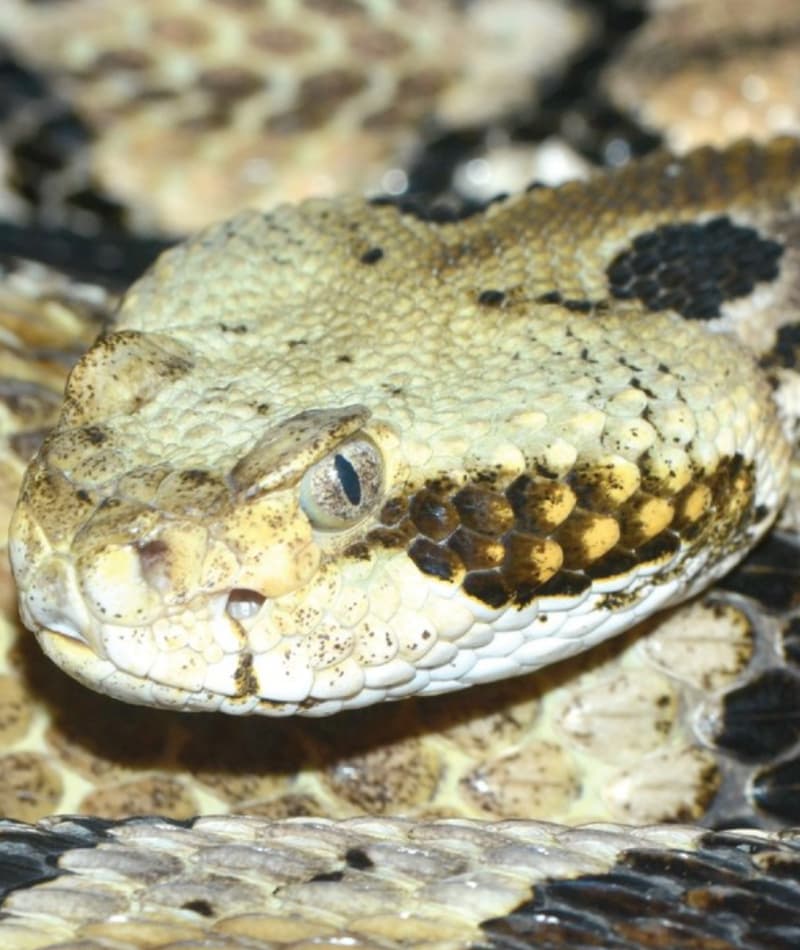
Timber Rattlesnake
Crotalus horridus
Did you know?
- Timber rattlesnakes are part of the Viperidae family, which they share with other vipers.
- They live in woodlands and scrublands in the east half of the United States.
- They are the largest venomous snakes in Missouri.
- They can recognize their siblings, even after they were separated at birth.
- Females can birth five to 14 babies at a time.
Adaptations
Like other North American vipers, timber rattlesnakes have a broad, flat, triangular-shaped head. Their head is colored yellow, tan, or gray, and usually has a dark line running from each eye to the jaw. Their main body color may be yellow, tan, brown or gray. Dark markings appear in bands around the body. Their coloring helps them camouflage in woods, bushes, branches, and leaves. Able to grow to lengths over five feet, they are venomous and large, making them top predators in their ecosystems. However, they are generally shy towards people.
Reproduction
Male timber rattlesnakes engage in a special "combat dance" when they encounter each other, especially if a female is nearby. The mating season occurs either in the spring or in late summer. A male timber rattlesnake courts a willing female with a special three-step "dance." First, he moves alongside and on top of the female. Then he starts rubbing his head and body against hers with jerky movements. Finally, he curls his tail under the female's tail, and mating takes place.
The female gives birth to live young in late summer or early fall. A litter may have anywhere from five to 14 live baby snakes, with eight being the average. Newborns are about 10 to 13 inches long, and are somewhat lighter in color than adults. Babies are born with a single tiny rattle segment (called a button) on their tail. Each time the skin is shed, a new segment is added to the base of the tail. Female timber rattlesnakes keep close watch over their young, a trait that is rather unusual among snakes. Female timber rattlers even lay scent trails to help their offspring find winter dens.
Threat Level
- Unknown
- Common
- Near Threatened
- Threatened
- Endangered
- Critically Endangered
- Extinct in the Wild
Common
Timber rattlesnakes are widespread and abundant.
Range
Eastern United States
Habitat
Heavily wooded upland forests with rocky outcops

We care about Timber Rattlesnakes
Since 1998, the Saint Louis Zoo has been helping biologists to study the timber rattlesnake. The Saint Louis Zoo supports this species in the Charles H. Hoessle Herpetarium at the Zoo. Learn more about how we are helping wildlife around the world.
Find this animal in Historic Hill

SAINT LOUIS ZOO ZONE
Historic Hill
Historic Hill is a lovely stroll through one of the oldest parts of the Saint Louis Zoo. From the 1904 World’s Fair Flight Cage to the Spanish architectural flavor of the 1920s in the Bird House, Primate House and Herpetarium to the finishing touches of our thoroughly modern exhibits, this area of the Zoo has a unique ambiance and a nostalgic history that make it a great destination.

